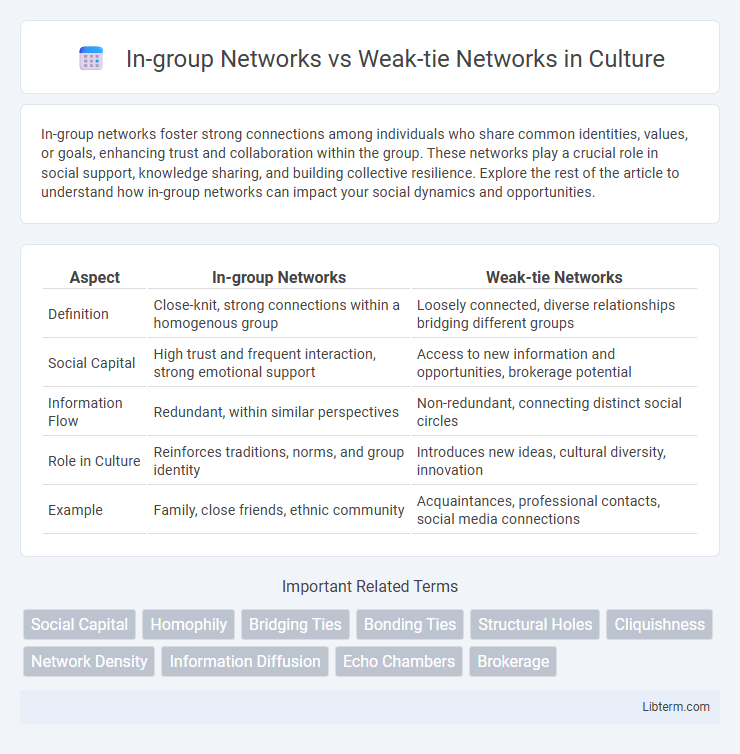In-group networks foster strong connections among individuals who share common identities, values, or goals, enhancing trust and collaboration within the group. These networks play a crucial role in social support, knowledge sharing, and building collective resilience. Explore the rest of the article to understand how in-group networks can impact your social dynamics and opportunities.
Table of Comparison
| Aspect | In-group Networks | Weak-tie Networks |
|---|---|---|
| Definition | Close-knit, strong connections within a homogenous group | Loosely connected, diverse relationships bridging different groups |
| Social Capital | High trust and frequent interaction, strong emotional support | Access to new information and opportunities, brokerage potential |
| Information Flow | Redundant, within similar perspectives | Non-redundant, connecting distinct social circles |
| Role in Culture | Reinforces traditions, norms, and group identity | Introduces new ideas, cultural diversity, innovation |
| Example | Family, close friends, ethnic community | Acquaintances, professional contacts, social media connections |
Understanding In-group Networks
In-group networks consist of tightly connected individuals who share strong emotional bonds, trust, and frequent interactions, facilitating rapid information flow and mutual support. These networks enhance collaboration within homogenous groups but may limit exposure to diverse perspectives and novel ideas. Understanding in-group networks is essential for leveraging social cohesion and maintaining group solidarity while recognizing potential risks of insularity.
Defining Weak-tie Networks
Weak-tie networks consist of connections between acquaintances or individuals who interact infrequently, facilitating access to novel information and diverse perspectives beyond close-knit social circles. These networks contrast with in-group networks, which are characterized by strong ties among closely connected individuals sharing similar knowledge and resources. Weak-tie networks play a crucial role in information diffusion, innovation, and opportunities by bridging different social groups and reducing information redundancy.
Key Differences Between In-group and Weak-tie Networks
In-group networks consist of tightly connected individuals who share strong social bonds and similar backgrounds, fostering trust and frequent interactions. Weak-tie networks link diverse groups through occasional interactions, enabling access to novel information and opportunities beyond immediate circles. The key difference lies in the strength and frequency of connections, with in-group networks promoting cohesion and weak-tie networks facilitating innovation and broader social reach.
Trust and Support in In-group Networks
In-group networks foster high levels of trust and mutual support due to strong emotional bonds and frequent interactions among members. This trust enables efficient information sharing, collaboration, and collective problem-solving within tightly knit groups. The supportive nature of in-group networks often results in increased loyalty and resilience during organizational challenges.
Access to Information Through Weak-tie Networks
Access to information through weak-tie networks provides individuals with novel insights and diverse perspectives not typically found within in-group networks, which are characterized by strong, close-knit relationships. Weak ties act as bridges connecting separate social clusters, facilitating the flow of unique information across different groups and enhancing opportunities for innovation and problem-solving. Research in social network theory demonstrates that weak-tie networks significantly expand access to non-redundant information and increase social capital beyond localized in-group knowledge.
The Role of Homophily in Network Formation
In-group networks thrive on homophily, the principle that individuals tend to connect with others who share similar characteristics, values, or backgrounds, reinforcing strong, cohesive bonds and fostering trust. Weak-tie networks, by contrast, bridge diverse social groups and expose individuals to novel information and opportunities, although they typically involve less frequent and less emotionally intense interactions. Homophily plays a pivotal role in shaping in-group networks, driving the preference for similarity that reinforces social cohesion, while weak-tie networks depend on heterophily to connect disparate social clusters.
Innovation and Opportunity: Weak-tie Advantages
Weak-tie networks connect diverse social groups, fostering the exchange of novel information and unique perspectives critical for innovation. These networks enable access to opportunities beyond immediate in-group circles, facilitating collaborations and resource sharing across different industries or domains. Leveraging weak ties enhances creativity and competitive advantage by bridging knowledge gaps and expanding the pool of ideas.
Social Capital in In-group Networks
In-group networks generate strong social capital through dense connections and high trust among members, facilitating efficient resource sharing and mutual support. These tightly knit networks foster collective identity and reinforce social norms, enhancing cooperation and reciprocity. The accumulation of bonding social capital in in-group networks strengthens emotional ties and provides a robust safety net during times of need.
Network Flexibility and Diversity
In-group networks typically exhibit strong ties that foster high trust but limit network flexibility and diversity due to repetitive interactions within homogenous groups. Weak-tie networks connect diverse individuals across different social circles, enhancing flexibility by providing access to novel information and opportunities outside close-knit clusters. This diversity in weak-tie networks promotes innovation and adaptability, making them crucial for dynamic problem-solving and expanding professional reach.
Strategic Networking: Balancing In-group and Weak-tie Connections
Strategic networking requires balancing in-group networks, characterized by strong, trust-based relationships, with weak-tie networks that provide access to diverse information and novel opportunities. In-group connections enhance collaboration and support within familiar circles, whereas weak-tie connections bridge different social clusters, fostering innovation and career growth. Effective network management leverages both types to optimize resource exchange, information flow, and strategic influence.
In-group Networks Infographic

 libterm.com
libterm.com